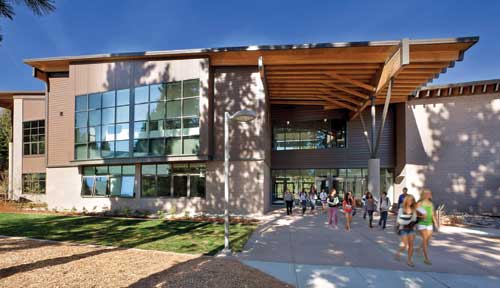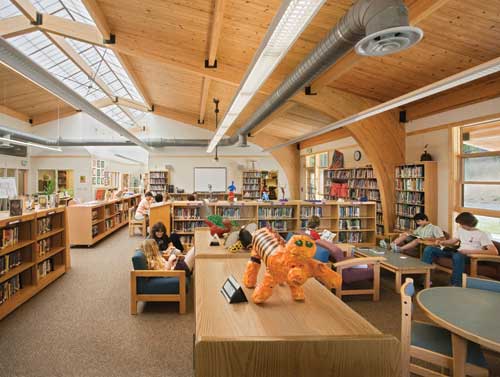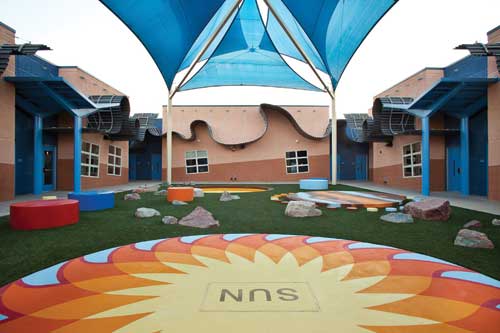Wood Scores A+ for Schools & Student Housing
| SOUTH TAHOE HIGH SCHOOL | ||
|
||
|
Location: South Lake Tahoe, California With wood beams and clerestory lighting, the South Tahoe High School looks at home in its mountain setting. “Wood was the only material capable of creating the ‘alpine’ appearance desired by the client and the community,” says LPA Principal Wendy Rogers, AIA, LEED AP, who selected Douglas-fir for the structural members. “Cost was an important factor, but not the only one. Because much of the structure is visible, it acts as both structural system and finish. This supports the alpine theme, the budget, and a more sustainable approach to design.” Durability was a key consideration. The architecture addresses extreme winter issues, with snow design loads of 150 pounds per square foot forcing large structural members and an intricate roofing solution. “The wood roof structure was covered by a roofing system composed of modified bitumen over a rigid polyisocyanurate insulation and rubberized, self-adhered membranes to act as a vapor barrier,” says Rogers. “The beam members exposed in overhangs were protected with a galvanized metal cap and all undersides of exposed members were protected with a clear water-resistant coating.” Rogers’ team also looked to the roof to increase functionality, creatively addressing a ubiquitous school problem—noise. Using a combination of exposed beams and recycled cotton insulation, the ceilings were manipulated to create a precise acoustic system. Recycled cotton was adhered to the underside of the deck, and between the remaining beams the slope of the exposed system was angled to reflect sound back into the space. “Because multiple spaces within the school are often used simultaneously, the acoustics within a space were as important as minimizing the sound transfer between spaces,” says Rogers. “Achieving an acoustically sound space often requires additive products and layers of materials to produce the appropriate reflective or absorptive qualities. At Tahoe, the team approached this challenge with a sustainable solution that honors the exposed roof structure.” |
| DUKE SCHOOL | ||
|
||
|
Location: Durham, North Carolina The private K-8 Duke School, located adjacent to the Duke Forest, used wood for multiple purposes from aesthetics to cost savings to energy efficiency. Early in the design phase, architects compared the cost of wood and steel structures. “The costs were comparable, but the aesthetics, sustainability, and constructability advantages of wood made it an easy choice for the owner and design team,” says DTW’s Robert Sotolongo, AIA, LEED AP. Designers took advantage of a glulam timber structure and wood stud walls to achieve high insulation values in the exterior building envelope, which had both cost and environmental benefits. The roof achieved a rating of R-22 with a combination of rigid nail base insulation over 2x6 wood decking with plywood sheathing board. Walls were R-19, achieved with R-19 batt insulation in a 2x6 wood stud wall. “The wood structure along with measures such as reflective metal roofing, high-efficiency heat pumps, daylighting, and solar hot water heating made for energy efficiency,” says Sotolongo. “Utility bills average about $.75 a square foot.” A warm, rich aesthetic was created using a variety of complementing woods. “Along with integration of daylighting and exterior views, the exposed wood structure has created a warm, enriching environment,” says Sotolongo. “The color palette of the natural wood structure and finishes complements the school’s informal and open educational philosophy, and the open floor plan enables the wood to unify the design.” The structure and decking of the school buildings is Southern Yellow Pine. Glulam columns, girders, purlins and arches comprise the main structural frames, with exposed tongue-and-groove wood roof decking used as a design element. Exterior walls are wood studs with plywood sheathing; interior walls feature wood studs with pressure-treated wood floor plates. Western Pine windows are clad with aluminum. |
| JACOB E. MANCH ELEMENTARY SCHOOL | ||
|
||
|
Location: Las Vegas, Nevada Hailed as Nevada’s first green school, the key part of the phased replacement of the Jacob E. Manch Elementary School is a new 70,000-square-foot facility incorporating a host of environmentally progressive features, such as classrooms entirely lit with natural light—the result of more than 500 skylights and many windows. In addition, the school is the first in the western U.S. to be built with structural insulated panels (SIPs), high-performance panels consisting of an insulating foam core sandwiched between two structural facings of OSB. “We selected SIPs because they allow more insulation and thus improve energy efficiency, and for acoustic reasons as the panels help mitigate jet aircraft noise from the nearby air force base,” says Ken Small, AIA, LEED AP of SSA Architecture. Plus, he says, “almost every wall in the school is tilted to cut down on reverberation time and reduce jet noise. When you look at the school, it looks like something the architects did to make it fun for the kids, but it actually has a purpose.” Cost was also a factor in using SIPs. “Estimation of concrete masonry units [CMU] and tilt-up concrete panels and replacement with SIPs resulted in approximately $1 million in direct construction cost savings,” Small says. In the Nevada desert with extremes of heat and cold, SIPs were a better choice than concrete, which absorbs heat during the day, placing significant burden on the cooling system. Because SIPs offer high R-value insulation and air tightness, they limit cooling losses through the building envelope. As a result, mechanical system requirements were reduced by 50 percent, and the school experiences lower ongoing operational costs. In January 2011, the school district facilities staff announced that Manch was the most energy-efficient elementary school per square foot among the hundreds of elementary school buildings in the school district. |












